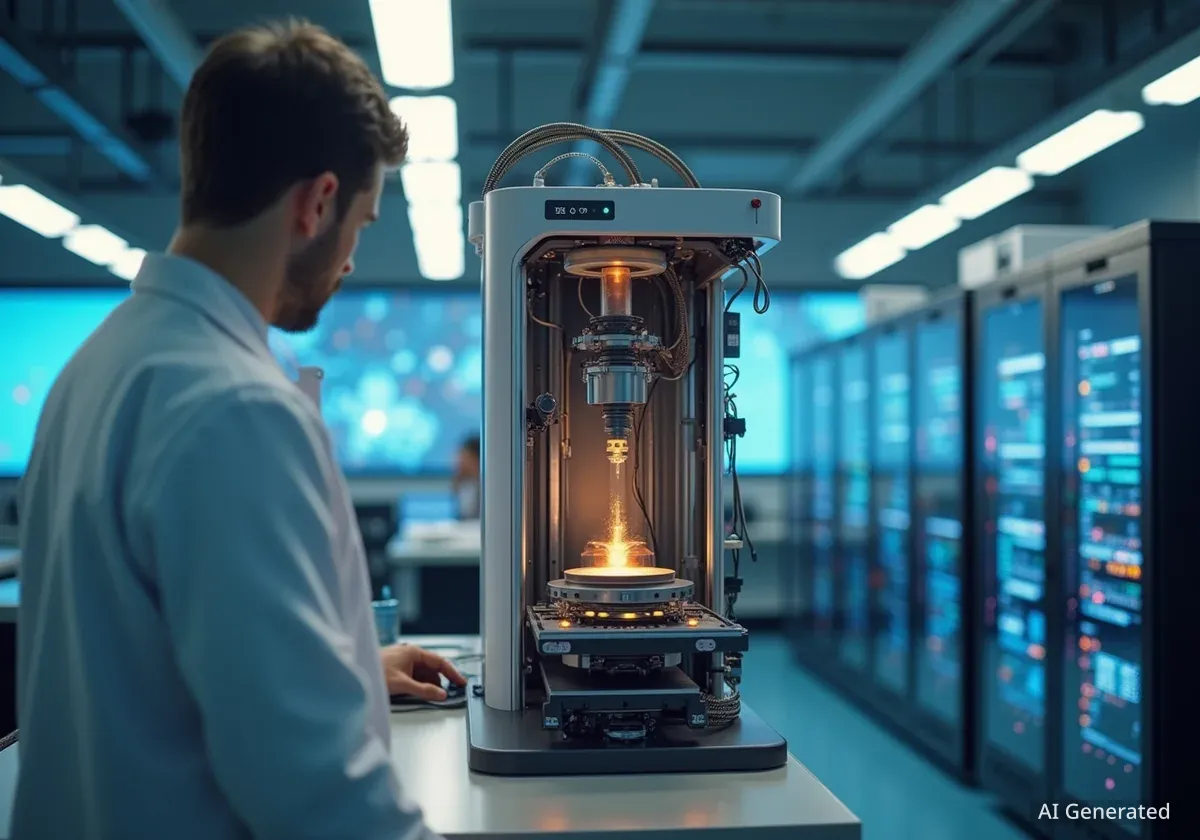Google's DeepMind has introduced a new artificial intelligence tool designed to accelerate the discovery and synthesis of new inorganic materials. The tool, known as GNoME (Graph Networks for Materials Exploration), has already been used to predict the structure of over 2.2 million new materials, with researchers successfully synthesizing more than 700 of them in laboratory settings.
This development aims to significantly shorten the timeline for creating novel materials used in technologies like batteries, solar panels, and computer chips. The findings were published in the journal Nature, highlighting a major step forward in applying AI to materials science.
Key Takeaways
- DeepMind's AI tool, GNoME, has predicted 2.2 million new stable inorganic crystals.
- Researchers have independently synthesized over 700 of these new materials.
- The project increases the number of known stable materials by nearly tenfold.
- The data is being shared publicly to aid global research efforts in various technology sectors.
AI Accelerates Scientific Discovery
The process of discovering new materials has traditionally been slow and labor-intensive, often relying on trial-and-error experimentation. It can take years, sometimes decades, to move a new material from initial concept to practical application. DeepMind's GNoME project is designed to change this paradigm.
By using graph neural networks, the AI model can predict the stability of new atomic combinations. This allows scientists to focus their efforts on candidates that are most likely to be synthesizable and possess useful properties. The model was trained on data from the Materials Project, an existing database of known materials.
According to DeepMind, GNoME's predictions have dramatically increased the success rate of material synthesis in the lab. The AI's ability to identify promising candidates helps researchers avoid spending time and resources on unstable compounds.
Background on Materials Science
Materials science is an interdisciplinary field that studies the properties of matter and its applications. Discovering new materials with specific properties—such as high conductivity, strength, or energy storage capacity—is crucial for technological advancement. For example, lithium-ion batteries, which power most modern electronics, were the result of decades of materials research.
The Scale of the Discovery
Before the GNoME project, the scientific community had identified approximately 48,000 stable crystalline materials over centuries of research. The AI tool has expanded this knowledge base significantly, adding 2.2 million new potential materials to the list.
Of these 2.2 million predictions, DeepMind identified 380,000 as the most stable and promising candidates for experimental synthesis. These materials are considered strong contenders for use in next-generation technologies. The sheer volume of new candidates provides a vast playground for scientists and engineers.
By the Numbers
- 2.2 million new materials predicted by GNoME.
- 380,000 of these are considered highly stable.
- 736 new materials have already been successfully synthesized.
- 58,000 new materials are similar to graphene, showing potential for electronics.
Ekin Dogus Cubuk, a research scientist at DeepMind, emphasized the project's impact.
"We're seeing an acceleration in the discovery of new materials that we hope will be able to solve some of the world's most pressing challenges," Cubuk stated in a press release.
Practical Applications and Future Potential
The new materials identified by GNoME have potential applications across numerous industries. The database includes thousands of potential new conductors, which could lead to more efficient electronics and energy grids.
Better Batteries and Superconductors
A significant portion of the newly identified materials could be used in energy storage. For example, 528 potential lithium-ion conductors were found, which could lead to batteries that charge faster, last longer, and are safer than current models. This is more than 25 times the number of similar materials previously known.
The AI also identified materials that could function as superconductors. Superconductors are materials that can conduct electricity with zero resistance, a property that could revolutionize energy transmission and computing. While practical, room-temperature superconductors remain a distant goal, GNoME provides many new avenues for research.
Advancements in Computing
The project also uncovered nearly 58,000 new layered materials similar in structure to graphene. These two-dimensional materials are highly sought after for their potential use in creating smaller, faster, and more efficient semiconductors for the next generation of computer chips.
By making the entire database of 2.2 million predicted structures public, DeepMind and its collaborators hope to empower researchers worldwide. This open-source approach allows scientists from different fields to explore the data and identify materials relevant to their specific areas of work, from renewable energy to medical devices.
Collaboration and Validation
To validate the AI's predictions, DeepMind collaborated with researchers at Lawrence Berkeley National Laboratory and other institutions. An automated laboratory system was developed to synthesize many of the materials predicted by GNoME without human intervention.
This automated process was crucial for testing the AI's output on a large scale. The successful synthesis of 736 new materials provides strong evidence that the AI's predictions are reliable and can guide real-world experiments effectively.
Kristin Persson, director of the Materials Project at Berkeley Lab, highlighted the collaborative nature of the work. "This is about combining AI-driven prediction with experimental validation to create a powerful feedback loop for discovery," she explained. "The scale of this is unprecedented."
The successful integration of AI prediction with automated synthesis marks a new era in materials science. This approach not only speeds up the discovery process but also makes it more efficient, reducing the cost and effort required to find the building blocks of future technologies. The long-term impact will depend on how effectively the global scientific community utilizes this newly available wealth of information.





